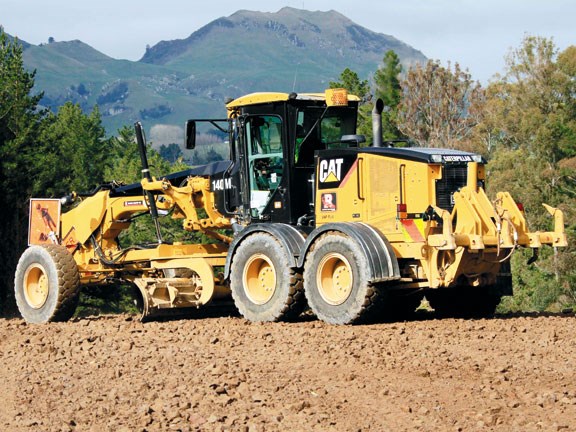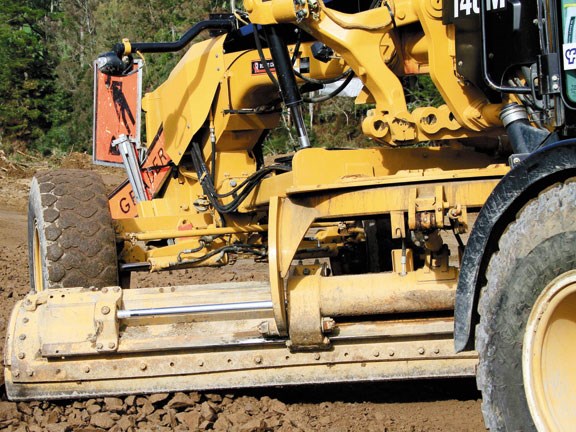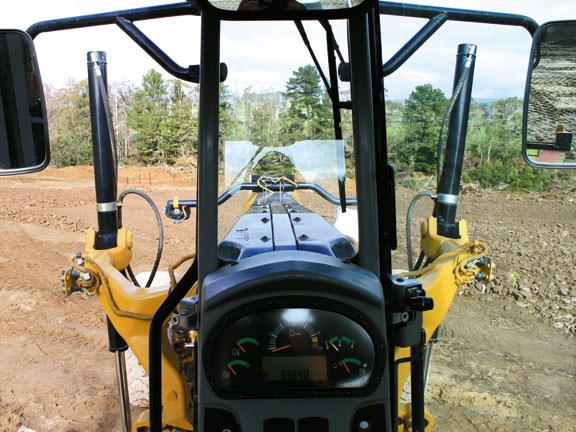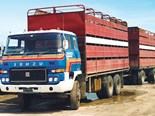Caterpillar 140M grader









|

|

|

|
The new Caterpillar M-series graders have dual joysticks for exceptional operator control. We test the brand’s 140M model grader
- Great external visibility
- All major functions on two easy-to-use joysticks
- Responsive hydraulics
- On-board lasers and GPS enhance accuracy
Thanks to Phil Rouse Ltd, in Tokoroa, I discovered exactly how easy a Cat 140M grader is to operate with its dual joysticks. Older models would see the busy operator spending a lot of time moving hands from one lever to the other, while holding the steering wheel.
Engine and power
The M-series graders begin with the 138hp 120M, with several models going up to the 259hp 14M. Then there are the 297hp 16M and massive 533hp 24M mining graders.
Powering the Caterpillar 140M I tested is a six-cylinder Cat C7 ACERT VHP engine, rated to Tier 3 emissions utilising an after-cooled exhaust gas system. The 7.2-litre motor features common rail fuel injection fed by a variable nozzle turbocharger to produce 136kW (183hp) at 2000rpm, and an automatically adjusting cooling fan.
Inside the cab
Caterpillar's M-series is the first watershed grader advance in years.
The quiet and roomy cab has large floor-to-ceiling glass for uninterrupted visibility, supported by angular doors, which permit viewing of the blade and wheels. Excellent rear vision is accomplished by three large mirrors and a sloped rear window. The analogue/digital dash is easy to read at a glance.
Pull both electro/hydraulic joysticks together to lift the moldboard/blade, and the opposite to lower it, as much as required on each side for correct cambering.
The left joystick on the 15130kg (base weight) 140M has the most functions. Move the lever left to turn left and right to go in that direction. Swivelling the lever left or right operates the articulation function. The top of the left joystick incorporates a pair of yellow buttons for gear changing (gear displayed on dash), plus a handy third yellow button for centring the wheels after using articulation.
Between these are two black buttons, which tilt the front wheels to grip the road better when taking a heavy cut. At the front of the left joystick is the easy to use forward/reverse trigger, plus neutral, partly making the foot clutch redundant.
The right joystick has a diff lock button at the front. A circular button allows the operator to change the blade angle in either direction, and to shift the hydraulic posts left or right for side grading. Simply swivel the joystick to rotate the blade for optimum angle, and move it left or right to bring the blade out to one side.
At the base of each lever are adjustable wrist rests and the controllers for the GPS and laser systems, when fitted. These are great for the likes of highway final trimming, bringing accuracy levels down to as little as 10mm and, when fitted, the graders can utilise 2D and 3D imaging from maps or plans.
The "A" pillar has a tree of toggle switches, which control the likes of automatic transmission changing for the road, cruise control, programmable auto gear shifting, hydraulic safety lock, and blade float to automatically lift the blade over obstacles. Below is the electronic interface for the service team, and below that is the ripper rise/fall switch.
Performance and handling
To move off in second (of eight) gear I released the Park brake then pulled the lower trigger on the left lever, varying my speed with the foot throttle lever. I'm happy to report that steering was a piece of cake.
When I lowered the blade and began grading a rough track, the hydraulics responded to each of my movements in carefully measured quantities to offer a fantastic level of control. This was especially good for the all-important blade rise/fall, but also blade swivel and when articulated turning - with the angle displayed on the analogue/digital dash.
All the controlling is done entirely on the two joysticks, so the only time I took my hand off one was to adjust the overhead air conditioner.
What the driver says…
Granger Church has been driving the 140M for a year.
"The visibility is not too bad. With the old machine you're mainly standing working the levers, so now you're above the blade looking down on everything. This one is more laid back and relaxed," he says.
Church normally grades in second gear, but on the road he'll be using eighth. He says it took him about an hour to get used to using the more touchy-at-speed joystick steering system during transport mode, but it wasn't hard learning the controls.
"Once you knew where everything was on the two control sticks, you're away," he says. "The 140M is much more responsive and quicker than the older ones. Manoeuvring the blade, tilting the wheels, the articulation - everything is right there in the palm of your hands."
See a range of graders for sale.
Specifications Number of cylinders Six-cylinder turbocharged, after-cooled Cat C7 ACERT VHP engine Capacity 7.2L Max power 136kW/183hp at 2000rpm Fuel tank 416L Transmission Direct drive, powershift, countershaft, eight forward and six reverse Top speed 46.6km/h forward, 35.6km/h reverse Length 10144mm, counterweight to rippers Width 2493mm, outside front tyres Height 3293mm Turning radius 7.75m, outside front tyres Steering angle 47.5 degrees Articulation angle 20 degrees GVW weight 15130kg base weight, 23,077kg maximum Ground clearance 341mm at rear axle Blade width 370mm Max lift above ground 480mm Max depth of cut 715mm Ripper shank holders Five Max ripper depth 428mm
Keep up to date in the industry by signing up to Deals on Wheels' free newsletter or liking us on Facebook.



.jpg)



.png)
.png)

